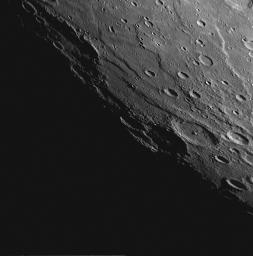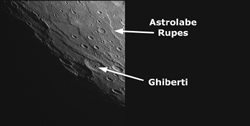
|
Astrolabe Rupes and More
- Click the image above for a larger view
- Full-Res JPEG (1018 x 1029) (98.7 kB)
- Full-Res TIFF (1018 x 1029) (1.0 MB)
Caption:

Click on image for larger annotated version
This NAC image, taken about 85 minutes after MESSENGER's closest approach during the mission's second Mercury flyby, shows a view of Astrolabe Rupes, named for the ship of the French explorer Jules Dumont d'Urville. Rupes is the Latin word for cliff. Mercury's day/night transition (the terminator) is located on the left side of the image, and the Sun is striking the cliff face of Astrolabe Rupes in the upper right of the image. Also visible in the image are additional unnamed rupes, whose cliff faces are casting dark shadows. One of these rupes intersects the crater Ghiberti, named for the Italian Renaissance sculptor. Rupes on Mercury are thought to have formed as the interior of Mercury cooled and the planet consequently contracted slightly. Determining the number and extent of rupes on Mercury can thus be used to understand the thermal history of the planet.
Date Acquired:
October 6, 2008
Image Mission Elapsed Time (MET):
131774936
Instrument:
Narrow Angle Camera (NAC) of the Mercury Dual Imaging System (MDIS)
Resolution:
660 meters/pixel (0.41 miles/pixel)
Scale:
Ghiberti crater is 123 kilometers in diameter (76 miles)
Spacecraft Altitude:
26,000 kilometers (16,000 miles)
Background Info:
These images are from MESSENGER, a NASA Discovery mission to conduct the first orbital study of the innermost planet, Mercury. For information regarding the use of images, see the MESSENGER image use policy .
Cataloging Keywords:
| Name | Value | Additional Values |
|---|---|---|
| Target | Mercury | |
| System | ||
| Target Type | Planet | |
| Mission | MESSENGER | |
| Instrument Host | MESSENGER | |
| Host Type | Orbiter | |
| Instrument | Mercury Dual Imaging System (MDIS) | |
| Detector | Narrow Angle Camera (NAC) | |
| Extra Keywords | Crater, Grayscale, Shadow, Thermal | |
| Acquisition Date | ||
| Release Date | 2008-10-14 | |
| Date in Caption | 2008-10-06 | |
| Image Credit | NASA/Johns Hopkins University Applied Physics Laboratory/Carnegie Institution of Washington | |
| Source | photojournal.jpl.nasa.gov/catalog/PIA11368 | |
| Identifier | PIA11368 | |
